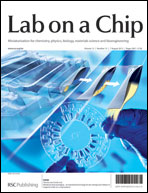Microstructure-induced helical vortices allow single-stream and long-term inertial focusing†
Abstract
Fluid inertia has been used to position microparticles in confined channels because it leads to precise and predictable particle migration across streamlines in a high-throughput manner. To focus particles, typically two inertial effects have been employed: inertial migration of particles in combination with geometry-induced secondary flows. Still, the strong scaling of inertial effects with fluid velocity or channel flow rate have made it challenging to design inertial focusing systems for single-stream focusing using large-scale microchannels. Use of large-scale microchannels (≥100 μm) reduces clogging over long durations and could be suitable for non-single-use flow cells in cytometry systems. Here, we show that microstructure-induced helical vortices yield single-stream focusing of microparticles with continuous and robust operation. Numerical and experimental results demonstrate how structures contribute to improve focusing in these larger channels, through controllable cross-stream particle migration, aided by locally-tuned secondary flows from sequential obstacles that act to bring particles closer to a single focusing equilibrium position. The large-scale inertial focuser developed here can be operated in a high-throughput manner with a maximum throughput of approximately 13 000 particles per s.


 Please wait while we load your content...
Please wait while we load your content...